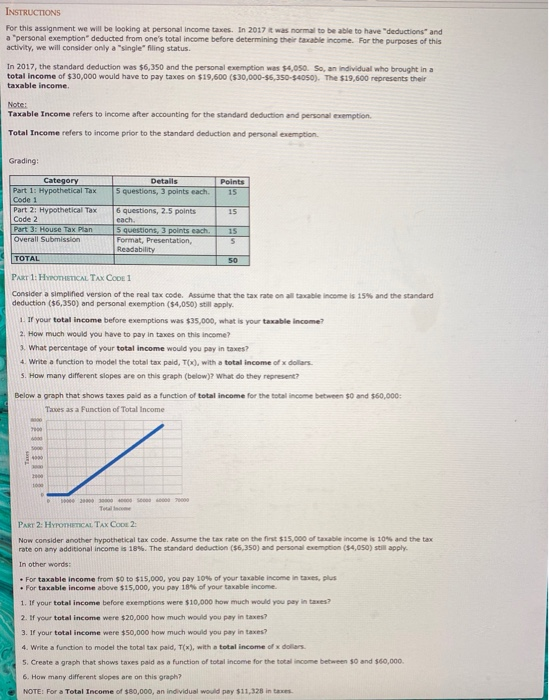INSTRUCTIONS For this assignment we will be looking at personal income taxes. In 2017 it was normal to be able to have "deductions and a personal exemption" deducted from one's total income before determining their taxable income. For the purposes of this activity, we will consider only a "single" filing status. In 2017, the standard deduction was $6,350 and the personal exemption was $4,050. So, an individual who brought in a total income of $30,000 would have to pay taxes on $19,600 ($30,000-$6,350-$4050). The $19,600 represents their taxable income Note: Taxable income refers to income after accounting for the standard deduction and personal exemption. Total Income refers to income prior to the standard deduction and personal exemption Grading: Points 15 Category Part 1: Hypothetical Tax Code 1 Part 2: Hypothetical Tax Code 2 Part 3: House Tax Plan Overall Submission 15 Details 5 questions, 3 points each. 6 questions, 2.5 points each. 5 questions, 3 points each. Format, Presentation, Readability 15 5 TOTAL 50 PART 1: Hyo TICAL TAX Code 1 Consider a simplified version of the real tax code. Assume that the tax rate on all taxable income is 15% and the standard deduction ($6,350) and personal exemption ($4,050) still apply. 1. If your total income before exemptions was $35,000, what is your taxable income? 2. How much would you have to pay in taxes on this income? 3. What percentage of your total income would you pay in taxes? 4. Write a function to model the total tax paid, Ox), with a total income of dollars. 5. How many different slopes are on this graph (below)? What do they represent? Below a graph that shows taxes paid as a function of total income for the total income between $0 and $60,000: Taxes as a function of Total Income 790 so 10000000000000 PART 2: HYPOTHETICAL TAX Cor 2: Now consider another hypothetical tax code. Assume the tax rate on the first $15,000 of taxable income is 10% and the tax rate on any additional income is 18%. The standard deduction ($6,350) and personal exemption (54,050) still apply. In other words: . For taxable income from 50 to $15,000, you pay 10% of your taxable income in awes, plus . For taxable income above $15,000, you pay 18% of your taxable income. 1. If your total income before exemptions were $10,000 how much would you pay in taxes? 2. If your total income were $20,000 how much would you pay in taxes? 3. If your total income were $50,000 how much would you pay in taxes? 4. Write a function to model the total tax pald, T(x), with a total income of dollars. 5. Create a graph that shows taxes paid as a function of total income for the total income between 0 and $60,000 6. How many different slopes are on this graph? NOTE: For a Total Income of $80,000, an individual would pay $11,328 in







